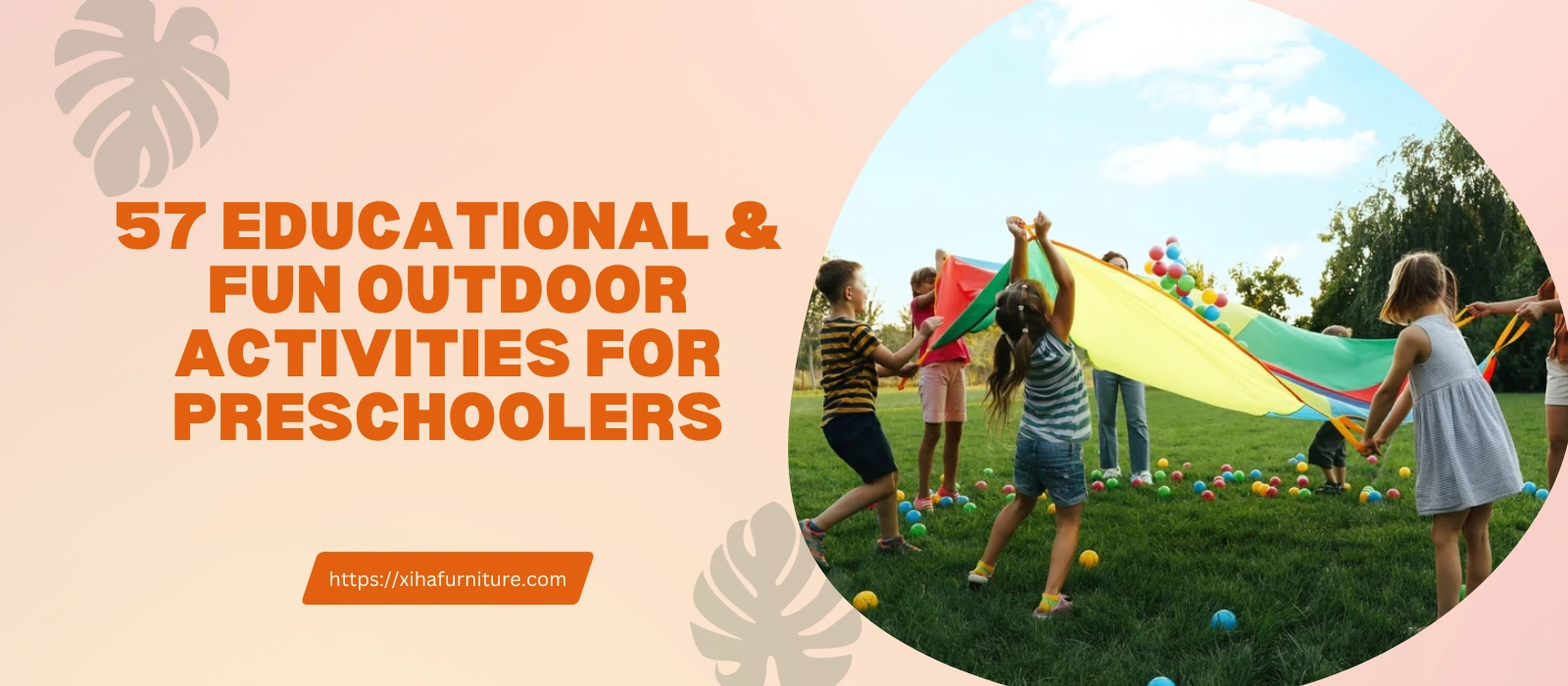Are you struggling to get preschoolers off screens and into the fresh air? Do they get bored easily, or seem to lack focus and energy? Are you wondering how to combine fun and learning without needing high-tech gadgets or expensive indoor setups? You’re not alone—these concerns are shared by parents, teachers, and kindergarten owners worldwide.
Outdoor activities for preschoolers are not only fun but essential. They help children build physical strength, boost creativity, enhance social skills, and learn through direct contact with nature. When young kids engage in structured and free play outdoors, they become healthier, happier, and more prepared for future academic success.
In today’s world where children are growing up surrounded by screens, it’s more important than ever to reconnect them with the natural world. Outdoor activities for preschoolers offer an irreplaceable experience—full-body movement, real-world problem-solving, and authentic social interaction. Let’s explore how we can make outdoor learning a joyful and educational journey for every preschooler.
Why Outdoor Play Matters for Preschoolers
Outdoor activities for preschoolers are far more than just a way to “burn off energy.” These experiences serve as powerful developmental tools that nurture every aspect of early childhood. When preschoolers engage in outdoor activities, they are building more than muscles—they are constructing the foundation of lifelong skills, attitudes, and abilities.
From a physical standpoint, outdoor activities for preschoolers promote gross motor development, coordination, and balance. Running, jumping, climbing, and navigating natural terrain challenge young bodies in a way that structured indoor play simply can’t. These movements also stimulate neural pathways that support cognitive functions like memory and spatial awareness.
Socially, outdoor activities for preschoolers encourage collaboration, negotiation, and imagination. Whether they’re building a fort, pretending to be explorers, or playing tag, children learn how to communicate, solve problems together, and express themselves freely. These peer interactions in a natural setting are crucial for emotional regulation and empathy.
Cognitively, outdoor activities for preschoolers nurture curiosity. Nature becomes a dynamic classroom where children ask questions, observe patterns, and test ideas. A puddle turns into a science experiment; a stick becomes a magic wand or a ruler. This type of learning—hands-on and sensory-rich—boosts understanding and retention more effectively than passive activities.
Emotionally, the benefits are profound. Exposure to fresh air, sunlight, and green environments reduces stress, increases serotonin, and supports mental health. In fact, studies show that time outdoors is directly linked to improved mood, attention span, and sleep quality in young children. Source
In sum, outdoor activities for preschoolers are not an optional extra; they are a core part of childhood education. They help preschoolers grow into confident, capable, and curious individuals who are ready to take on the world.
How to Get Started with Outdoor Activities for Preschoolers
Getting started with outdoor activities for preschoolers doesn’t have to be overwhelming. In fact, a few thoughtful preparations can turn any open space into a rich and engaging learning environment. Whether you’re a kindergarten teacher, daycare provider, or parent, there are simple ways to integrate outdoor play into a child’s daily routine.
1. Identify Your Space: Determine whether you’re working with a schoolyard, public park, backyard, or rooftop terrace. Each setting has its own opportunities for exploration, from grassy patches to sandboxes, water features, and climbing structures.
2. Safety First: Preschoolers are curious and active. Make sure the area is safe—clear away hazards like broken glass, sharp rocks, or slippery surfaces. Always supervise and establish boundaries that are easy for kids to understand.
3. Choose the Right Time: Outdoor activities for preschoolers are best done in the morning or late afternoon, avoiding peak sun hours. Dress children appropriately for the weather and provide sunscreen, hats, or warm layers depending on the season.
4. Prepare Materials: Not all activities require expensive equipment. Many can be done with common items like buckets, chalk, ropes, or recycled containers. Keep materials portable and organized to encourage flexibility and spontaneity.
5. Mix Structure with Free Play: Offer a balance. Plan structured activities with clear goals (like scavenger hunts or relay races), but also allow free play time where kids can use their imagination and social skills without guidance.
6. Involve the Children: Let preschoolers help choose or create activities. Their ideas often bring surprising creativity, and their engagement increases when they feel a sense of ownership over the play.
7. Evaluate and Adjust: After each activity, reflect on what worked well and what could improve. This helps you refine the experience, ensure safety, and align better with learning objectives.
By following these simple steps, you’ll be able to make outdoor activities for preschoolers a seamless, enriching, and joyful part of early childhood education.
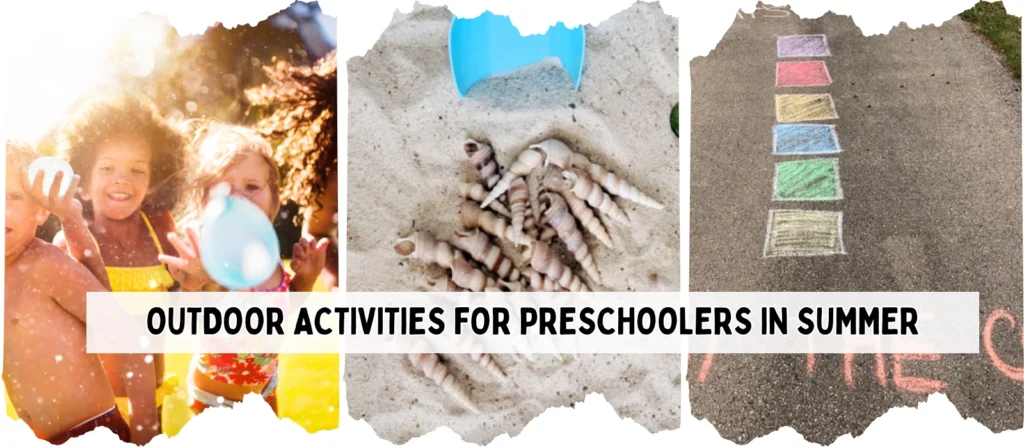
Outdoor Activities for Preschoolers in Summer
1. Nature Scavenger Hunt
Activity Introduction: This activity transforms a simple summer walk into an engaging nature discovery mission. It develops children’s observation and categorization skills as they hunt for different textures, colors, and shapes in nature. It’s also a great way to introduce basic science and vocabulary in a hands-on format, allowing children to connect directly with the natural world. The excitement of finding each item on the list keeps preschoolers curious, focused, and moving.
Materials Needed:
- Printable scavenger hunt list (leaf, bug, stick, rock, bird, etc.)
- Crayons or markers
- Small basket or bag for collections
How to Do It: Create or print a picture-based list of items children can find outside. Walk through a local park, garden, or school yard and encourage kids to check off or collect each item as they spot it.
2. Water Balloon Toss
Activity Introduction: This classic summer favorite offers more than just a way to cool off—it improves hand-eye coordination, timing, and gross motor planning. The game is dynamic and laughter-filled, encouraging social interaction, cooperation, and spatial awareness. Children also learn cause-and-effect (if they drop it, it bursts!) in a highly sensory way. It’s great for group play and works well during summer events or water-themed days.
Materials Needed:
- Water balloons
- Buckets or water source
- Towels
How to Do It: Fill balloons and pair up children. Have them toss and catch the balloons, stepping further apart after each successful catch. The team that avoids bursting their balloon the longest wins.
3. Sand and Shell Sensory Play
Activity Introduction: Perfect for hot days, this tactile activity engages multiple senses while fostering creativity and fine motor skills. As children dig, scoop, pour, and build, they’re exploring different textures and practicing hand strength and coordination. Shells add a natural element to imaginative play, whether they’re used as money in a pretend store or as treasure in an excavation site. It also creates a calm, focused play environment for kids who enjoy sensory input.
Materials Needed:
- Sandpit or sandbox
- Seashells, small shovels, and containers
How to Do It: Invite preschoolers to dig, build, and create with sand and shells. They can bury treasure, build castles, or make pretend food—whatever inspires them.
4. Sidewalk Chalk Obstacle Course
Activity Introduction: This activity turns any sidewalk or concrete space into an interactive movement game. It combines creativity with physical activity, allowing kids to design and navigate a colorful course. By hopping, spinning, crawling, or zigzagging along chalk-drawn paths, children practice gross motor skills and following directions. It also offers opportunities to introduce counting, patterns, and even early reading prompts like action verbs.
Materials Needed:
- Sidewalk chalk
How to Do It: Draw a winding path with instructions like “hop 5 times,” “spin in a circle,” or “walk like a crab.” Kids follow the course as they burn energy and practice gross motor skills.
5. Bubble Chase
Activity Introduction: Bubble play captures the imagination and excitement of preschoolers like few other activities. While chasing and popping bubbles, children are developing agility, speed, and spatial awareness. The unpredictability of where a bubble will float adds an element of problem-solving and anticipation. This activity is also ideal for mixed ability groups and can be calming for children with sensory processing needs.
Materials Needed:
- Bubble solution
- Bubble wands
How to Do It: Adults or children blow bubbles while others chase and pop them. Use different wand shapes or homemade solutions to mix it up.
6. Ice Cube Painting
Activity Introduction: This creative summer activity introduces concepts of color theory, temperature, and cause-and-effect in a fun and artistic way. Children use melting ice cubes as paintbrushes, which also cools them down during hot weather. It’s a unique sensory experience that enhances fine motor skills and encourages experimentation with design and blending colors. Plus, it’s an easy clean-up art project ideal for outdoor spaces.
Materials Needed:
- Ice cube tray
- Water, food coloring, popsicle sticks
- White paper
How to Do It: Freeze colored water in trays with sticks. Once frozen, kids use the cubes like paintbrushes to draw on paper outside, watching how the colors melt and mix.
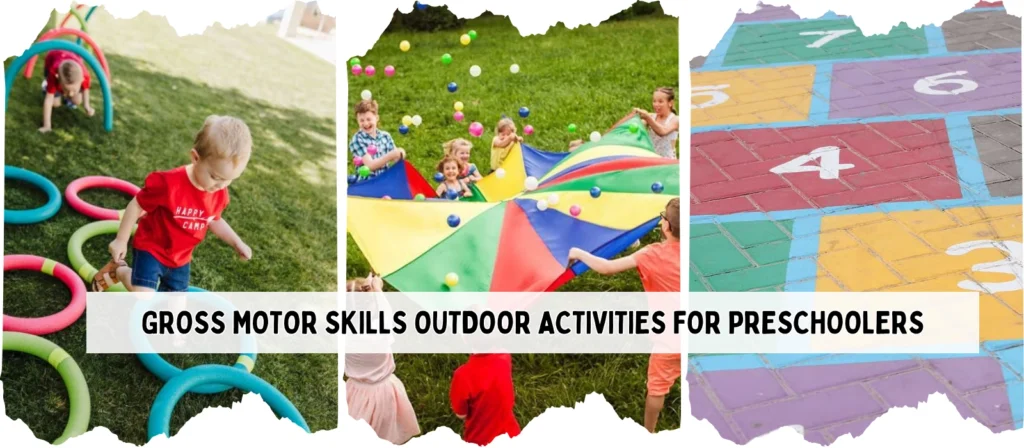
Gross Motor Skills Outdoor Activities for Preschoolers
1. Animal Relay Races
Activity Introduction: This energetic game supports the development of large muscle groups through imaginative movement. Preschoolers love to pretend, and this activity lets them become their favorite animals while moving in unique and dynamic ways. It’s perfect for open spaces and helps burn energy while promoting coordination, speed, and agility.
Materials Needed:
- Cones or markers to set up lanes
- A timer or whistle (optional)
How to Do It: Create a race path and assign each child an animal movement—hop like a frog, crawl like a bear, waddle like a penguin. Let them race in groups or individually and cheer for every effort.
2. Obstacle Course Adventure
Activity Introduction: Enhances strength, balance, and coordination while making children feel like little explorers. Obstacle courses provide multi-sensory experiences, requiring kids to crawl, climb, jump, and maneuver around different challenges. These dynamic movements develop gross motor skills while also building perseverance and problem-solving abilities.
Materials Needed:
- Hula hoops, tunnels, cones, ropes
- Mats or soft landing surfaces
How to Do It: Set up a series of obstacles in an open space—crawl under a rope, jump through hoops, balance on a line. Explain each step and let children navigate through it at their own pace.
3. Parachute Play
Activity Introduction: Promotes teamwork, arm strength, and core stability through rhythmic motion games. Parachute activities are exciting and inclusive, encouraging every child to participate equally. They can help preschoolers learn about cause and effect while synchronizing their movements with peers for a common goal.
Materials Needed:
- A large play parachute or bed sheet
- Small balls or lightweight toys
How to Do It: Gather children around the parachute, each holding an edge. Try classic games like “popcorn” (tossing balls into the center and shaking) or “mushroom” (lifting it up high and quickly ducking underneath).
4. Hopscotch Challenge
Activity Introduction: A nostalgic activity that builds lower body strength and introduces basic number recognition. Hopscotch improves balance, coordination, and hopping control, while subtly reinforcing early math skills. It’s a simple, cost-effective game that can be played almost anywhere with minimal setup.
Materials Needed:
- Sidewalk chalk or hopscotch mat
- Small beanbag or stone
How to Do It: Draw a hopscotch grid on the ground. Children toss the marker and hop across the squares, skipping the one with the marker. Reinforce number names while playing.
5. Tunnel Crawls
Activity Introduction: Builds core strength, balance, and spatial awareness in a fun, tactile way. This activity stimulates vestibular and proprioceptive systems while making movement fun. It’s especially useful for children who benefit from sensory integration, providing both exercise and calming pressure.
Materials Needed:
- Play tunnels or cardboard boxes
- Mats for soft landings
How to Do It: Set up tunnels across a grassy area or soft mat. Encourage kids to crawl through, race, or play hide-and-seek style games inside the tunnels.
6. Beanbag Toss
Activity Introduction: Helps with throwing accuracy, coordination, and body awareness. Tossing beanbags develops bilateral coordination and hand-eye targeting skills, which are essential for tasks like writing and catching. It’s adaptable to all skill levels and offers a competitive or collaborative format.
Materials Needed:
- Beanbags
- Bins, buckets, or targets
How to Do It: Place the bins at varying distances. Children stand behind a line and toss beanbags into them. Adjust the challenge by changing distances or assigning point values.
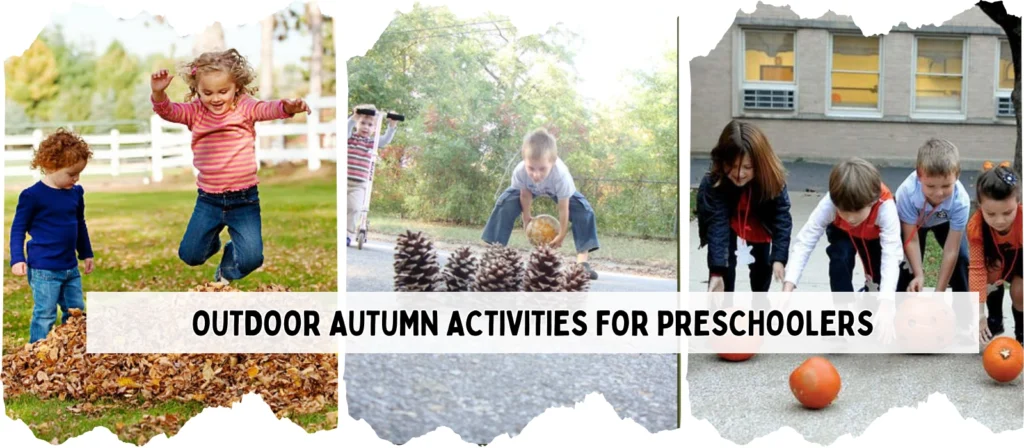
Outdoor Autumn Activities for Preschoolers
1. Leaf Pile Jumping
Activity Introduction: This outdoor activity for preschoolers is a seasonal favorite that builds gross motor skills while offering endless laughter. Jumping into leaf piles improves balance, coordination, and body awareness. It also teaches turn-taking and fosters sensory joy as kids feel the crisp textures and hear the satisfying crunch.
Materials Needed:
- Rakes
- Open space
- A collection of dry leaves
How to Do It: Help preschoolers gather leaves into a large, soft pile. Take turns jumping in, tossing them into the air, or playing pretend games like hide-and-seek. Always inspect the pile first for safety.
2. Pinecone Bowling
Activity Introduction: This creative twist on traditional bowling is one of the best outdoor activities for preschoolers in the fall. It improves aim, strength, and hand-eye coordination, and introduces preschoolers to basic physics like motion and direction—all in a fun, rustic format.
Materials Needed:
- Pinecones (as balls)
- Empty plastic bottles or small cones (as pins)
How to Do It: Arrange the bottles in a triangle shape. Let children roll the pinecones and try to knock over as many pins as possible. Keep score or play just for fun.
3. Acorn Hunt
Activity Introduction: Turn your preschoolers into little nature detectives! Acorn hunts stimulate curiosity, observation, and fine motor skills. They’re ideal for developing counting and sorting abilities, making them one of the most educational outdoor activities for preschoolers in autumn.
Materials Needed:
- Baskets or small bags
- Designated collection area (school yard, park)
How to Do It: Set boundaries and let kids gather acorns. Count, sort by size or color, and use them for future crafts. Use magnifying glasses for closer inspection and introduce vocabulary like “nut,” “shell,” or “oak.”
4. Pumpkin Rolling Races
Activity Introduction: These races are great for developing core strength and directional control. They’re also just plain fun and give preschoolers a chance to engage in seasonal sensory experiences. It’s one of those outdoor activities for preschoolers that’s ideal for harvest festivals or themed playdates.
Materials Needed:
- Small pumpkins (round and not too heavy)
- Cones to mark start and finish lines
How to Do It: Divide children into teams and have them roll pumpkins along a set course. They can race against each other or in a relay format. This activity encourages cooperation and builds motor planning.
5. Nature Collage Craft
Activity Introduction: Fall’s natural elements make it the perfect season for hands-on art. This outdoor activity for preschoolers integrates nature exploration with creativity and fine motor development. It’s calm, meditative, and produces frame-worthy artwork.
Materials Needed:
- Leaves, twigs, bark, seeds, grass
- Paper, glue sticks, and markers
How to Do It: Let children gather materials during a nature walk. Once back outside or in a sheltered area, they glue items onto paper to make their own autumn art. Encourage storytelling about what they’ve made.
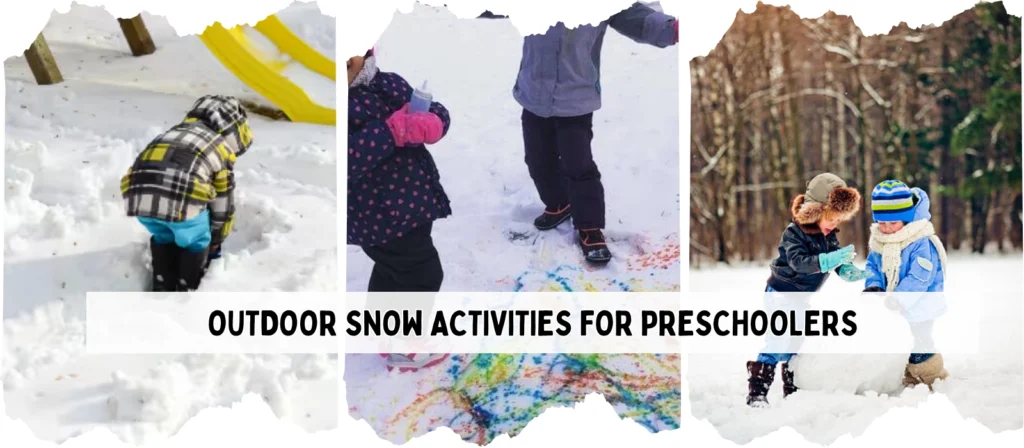
Outdoor Snow Activities for Preschoolers
1. Snow Maze Walk
Activity Introduction: This outdoor activity for preschoolers combines gross motor movement with spatial awareness and problem-solving. Creating and navigating a snow maze allows children to explore directionality, cooperation, and perseverance. It turns a cold winter day into a warm adventure filled with laughter and learning.
Materials Needed:
- Snow boots
- Markers, cones, or colored flags
How to Do It: Stamp or shovel paths into the snow to form a simple maze. Add dead ends and turns to keep it interesting. Let kids walk or run through it, or use it for races and group navigation challenges.
2. Snowball Toss Game
Activity Introduction: Perfect for developing coordination and aim, this outdoor activity for preschoolers is both energetic and engaging. The soft texture of snowballs makes it safe for young children to practice their throwing skills while also exploring winter textures.
Materials Needed:
- Packed snowballs
- Buckets or painted targets
How to Do It: Set up buckets at different distances. Let children toss snowballs and try to land them inside. Assign points for difficulty or make it a team challenge to encourage collaboration.
3. Snow Painting
Activity Introduction: Snow painting is a unique and colorful outdoor activity for preschoolers that allows artistic expression in a winter setting. It also introduces temperature and color-mixing concepts, all while developing hand strength and control.
Materials Needed:
- Spray bottles or squeeze bottles
- Water and food coloring
How to Do It: Fill bottles with colored water. Let children spray or drizzle paint across the snowy canvas. They can draw shapes, write letters, or simply explore color blending in a vibrant, hands-on way.
4. Build a Snow Friend
Activity Introduction: Building snowmen or snow creatures is a classic outdoor activity for preschoolers in winter that promotes teamwork and creativity. Lifting and shaping snow helps build muscle control and introduces concepts of size, balance, and design.
Materials Needed:
- Snow (slightly wet works best)
- Buttons, scarves, sticks, carrots, etc.
How to Do It: Demonstrate rolling and stacking snowballs. Let children decorate with natural or household items. Encourage them to create stories about their snow characters to spark language development.
5. Frozen Treasure Hunt
Activity Introduction: This thrilling outdoor activity for preschoolers develops problem-solving, fine motor skills, and sensory exploration. It transforms a simple snowy day into a treasure-seeking adventure that sparks imagination and excitement.
Materials Needed:
- Small waterproof toys or colored ice cubes
- Buckets, shovels, or scoops
How to Do It: Hide small treasures beneath the snow in a defined area. Provide clues or let kids freely dig and search. You can color-code the treasures or assign them numbers to add a counting element.
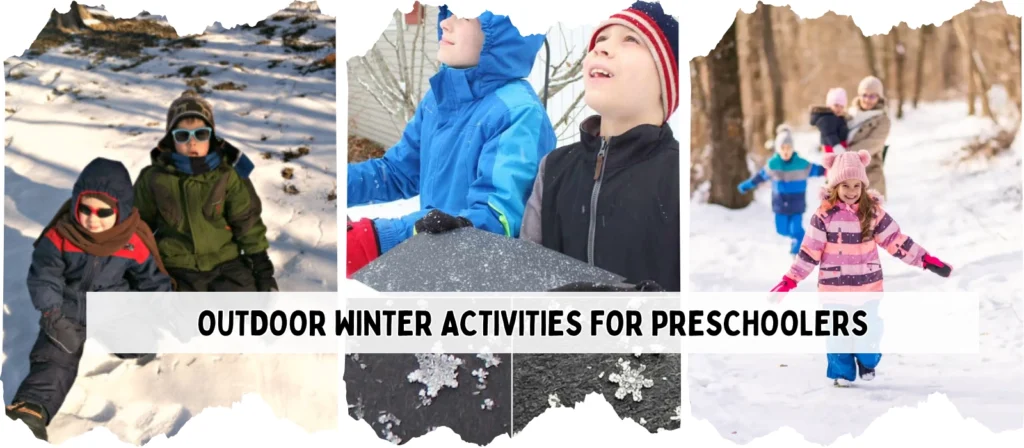
Outdoor Winter Activities for Preschoolers
1. Winter Nature Walk
Activity Introduction: This outdoor activity for preschoolers encourages exploration and observation in a winter landscape. It helps develop vocabulary, scientific thinking, and a love for nature, even in colder months. Children learn to appreciate seasonal changes and practice mindfulness as they walk, listen, and observe their chilly surroundings.
Materials Needed:
- Warm winter clothing
- Magnifying glass or binoculars
- Nature checklist or journal
How to Do It: Dress warmly and take a slow walk through a local park, garden, or school yard. Look for animal tracks, icicles, frost patterns, or birds. Ask questions and encourage kids to draw or record their findings in journals.
2. Ice Excavation Game
Activity Introduction: This hands-on winter outdoor activity for preschoolers promotes fine motor development and critical thinking. It’s a sensory-rich game that mimics real-life archaeology, providing both excitement and skill-building.
Materials Needed:
- Containers with frozen small toys inside
- Plastic spoons, eyedroppers, warm water
How to Do It: Freeze toys in containers overnight. Let children use tools and water to excavate the items. This enhances patience, concentration, and fine motor strength.
3. Snowflake Catching and Study
Activity Introduction: Observing falling snowflakes can spark wonder and introduce science concepts. This outdoor activity for preschoolers builds curiosity, focus, and descriptive language skills while connecting kids to natural beauty.
Materials Needed:
- Black paper or felt
- Magnifying glass
How to Do It: Catch snowflakes on black paper and use magnifying glasses to observe shapes and patterns. Discuss symmetry, texture, and why snowflakes melt. It’s short, simple, and magical.
4. Winter Animal Pretend Play
Activity Introduction: Imaginative play is powerful for development, and this outdoor activity for preschoolers uses winter themes to foster creativity, coordination, and empathy. Children pretend to be winter animals, learning about behavior, habitats, and movement.
Materials Needed:
- Animal masks or ears (optional)
- Open snow area
How to Do It: Assign animals like bears, foxes, or penguins. Encourage kids to mimic how each animal walks, hides, or stays warm. Add a storytelling element for deeper engagement.
5. Icicle Balance Challenge
Activity Introduction: This simple outdoor activity for preschoolers is both fun and skill-enhancing. Kids strengthen hand-eye coordination and fine motor skills while moving carefully with fragile icicles or frozen sticks.
Materials Needed:
- Collected icicles or thin frozen branches
- Cones or markers to walk around
How to Do It: Children balance icicles while walking along a marked path. Add variations like zigzagging or stepping over obstacles to increase difficulty.
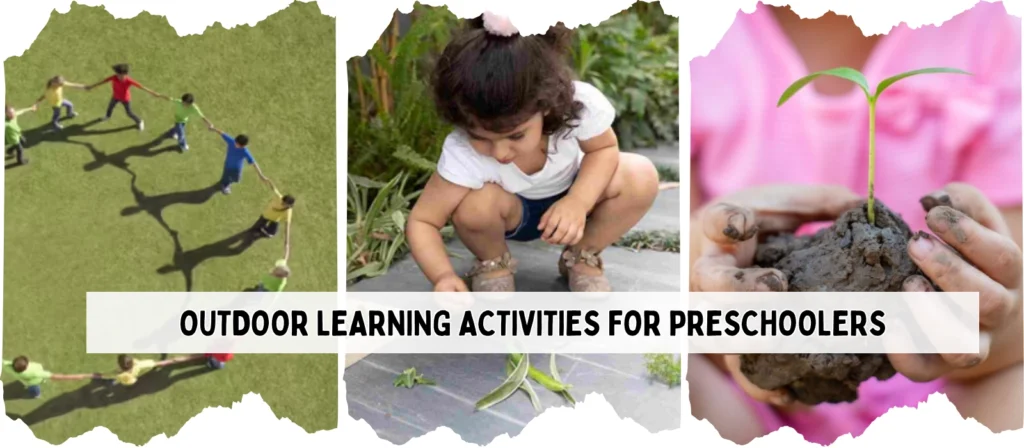
Outdoor Learning Activities for Preschoolers
1. Nature Alphabet Hunt
Activity Introduction: This enriching outdoor activity for preschoolers strengthens letter recognition and language development while immersing children in nature. By searching for objects that start with different letters, kids connect the alphabet to real-world items, making early literacy tangible and memorable.
Materials Needed:
- Alphabet checklist or cards
- Clipboards and pencils
How to Do It: Give each child a letter or a group of letters. Ask them to find natural objects whose names begin with those letters (like “L” for leaf or “S” for stick). Record findings on a chart or drawing.
2. Shape Walk
Activity Introduction: This outdoor activity for preschoolers enhances spatial thinking and geometry awareness by encouraging children to identify and compare shapes in the environment. It supports vocabulary development and observational focus.
Materials Needed:
- Shape cards or visual guides
- Journals or clipboards
How to Do It: Show children basic shapes and go on a walk to find objects that match—circles in tree rings, triangles in rooflines, rectangles on fences. Encourage sketching or photographing each discovery.
3. Color Sorting Picnic
Activity Introduction: This colorful outdoor learning activity for preschoolers introduces categorization and visual discrimination skills. Kids gather natural materials and sort them by color, learning basic science and math principles in a fun, picnic-style setting.
Materials Needed:
- Color-coded baskets or mats
- Natural objects (leaves, flowers, stones)
How to Do It: Set up an area with colored baskets. Ask children to collect and sort items they find outdoors. Discuss similarities and differences, encouraging descriptive language and comparison.
4. Weather Station Observation
Activity Introduction: This educational outdoor activity for preschoolers introduces scientific inquiry and environmental awareness. By observing daily weather conditions, children learn to document, predict, and understand natural changes.
Materials Needed:
- Thermometers, wind socks, rain gauges
- Observation charts
How to Do It: Designate a weather station outdoors. Each day, preschoolers take turns noting the temperature, wind direction, and cloud cover. Discuss patterns and help them graph the results weekly.
5. Plant Life Cycle Exploration
Activity Introduction: Engaging with plants teaches preschoolers about growth, change, and biology. This outdoor activity for preschoolers connects them directly to living systems and nurtures a sense of responsibility and care for the environment.
Materials Needed:
- Seeds, pots, watering cans
- Labels and journals
How to Do It: Guide children in planting seeds and observing their growth outdoors. Let them record changes and draw pictures. Discuss parts of the plant and what it needs to thrive.
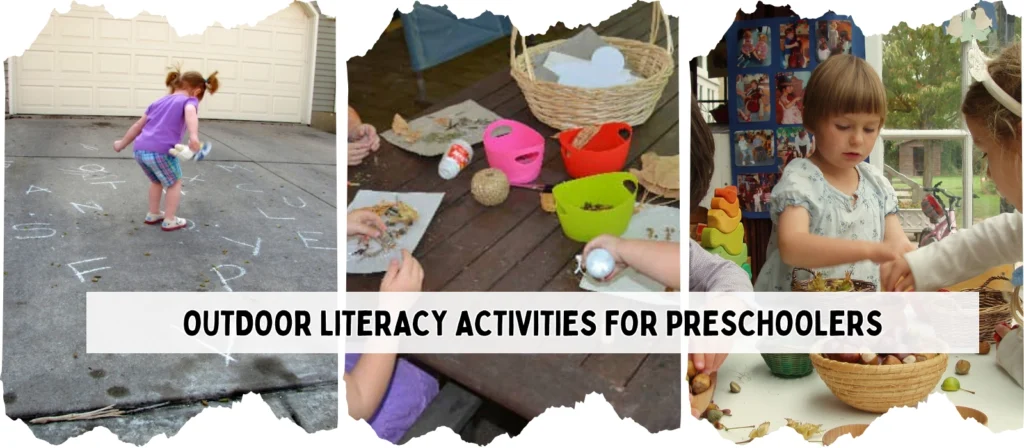
Outdoor Literacy Activities for Preschoolers
1. Storytime Circle
Activity Introduction: This cozy and interactive outdoor activity for preschoolers builds listening, language, and imagination skills. By sharing stories in an open-air setting, children connect with language in a peaceful and stimulating environment. It enhances vocabulary and comprehension while reinforcing the joy of books.
Materials Needed:
- Storybooks
- Picnic blanket or mats
- Props for acting out stories (optional)
How to Do It: Gather children in a circle outdoors and read a story aloud. Encourage predictions, questions, and participation. Add movement or role-play to enhance engagement.
2. Alphabet Hop Game
Activity Introduction: This movement-based literacy outdoor activity for preschoolers supports letter recognition, phonics, and motor coordination. It combines physical activity with foundational reading skills, making learning active and memorable.
Materials Needed:
- Chalk or foam alphabet mats
- Music (optional)
How to Do It: Write letters on the ground. Call out a letter or its sound, and have children hop to it. Add complexity by forming simple CVC words or practicing name spelling.
3. Nature Letter Tracing
Activity Introduction: This tactile outdoor activity for preschoolers strengthens fine motor skills and alphabet knowledge. Children use natural materials to shape letters, making the experience sensory-rich and interactive.
Materials Needed:
- Sticks, leaves, stones
- Alphabet cards for reference
How to Do It: Show a letter card and invite children to recreate it using materials found outside. This promotes creativity, muscle memory, and letter-sound association.
4. Word Hunt Walk
Activity Introduction: A blend of literacy and exploration, this outdoor activity for preschoolers builds word recognition and environmental print awareness. Kids search for letters and words in signs, posters, or labeled items in their outdoor environment.
Materials Needed:
- Clipboards or journals
- Word or letter list
How to Do It: Take children on a walk around a playground, garden, or nearby area. Encourage them to find and note down letters or words they see. Discuss their meanings and uses.
5. Rhyming Echo Game
Activity Introduction: Rhyming develops phonological awareness, a critical early reading skill. This outdoor activity for preschoolers combines rhythm, memory, and fun to boost sound recognition and listening skills.
Materials Needed:
- List of rhyming word pairs
- Open outdoor space
How to Do It: Say a word aloud, and ask children to echo it with a rhyming word. Move in a circle or toss a ball to pass turns. Make it silly and energetic to increase engagement.
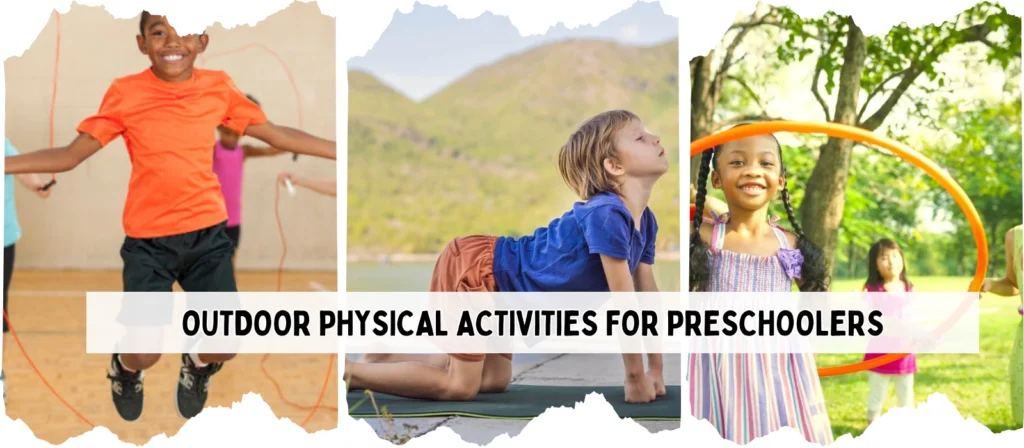
Outdoor Physical Activities for Preschoolers
1. Running Track Games
Activity Introduction: This outdoor activity for preschoolers is a timeless way to promote physical fitness, endurance, and speed. Structured running games help children learn to follow rules, pace themselves, and improve cardiovascular health. It’s also a fantastic way to expend energy in a controlled and educational environment.
Materials Needed:
- Cones or markers
- Stopwatch (optional)
- Whistle or flag
How to Do It: Set up a circular or straight running track using cones. Organize relay races, tag games, or timed laps. Encourage group cheers to boost motivation and teamwork.
2. Jump Rope Routines
Activity Introduction: Jumping rope enhances coordination, rhythm, and balance. This outdoor physical activity for preschoolers also strengthens leg muscles and improves cardiovascular health, all while integrating counting and musical beats.
Materials Needed:
- Jump ropes (short for individual, long for group)
How to Do It: Show basic jumping techniques and create routines. Let children take turns jumping alone or in pairs. Add chants or rhymes to boost engagement and memory.
3. Ball Skills Circuit
Activity Introduction: This dynamic outdoor activity for preschoolers builds gross motor control, hand-eye coordination, and teamwork. Rotating through ball-focused stations helps children practice multiple physical skills in a fun and challenging way.
Materials Needed:
- Assortment of balls (soccer, basketball, softballs)
- Cones for stations
How to Do It: Create 3–4 ball activity zones: dribbling, throwing at targets, kicking into goals, and partner tossing. Rotate groups every few minutes to keep it fresh.
4. Animal Yoga
Activity Introduction: Combining movement with mindfulness, this outdoor physical activity for preschoolers introduces balance, flexibility, and body awareness. Mimicking animal poses makes it playful while promoting calmness and focus.
Materials Needed:
- Yoga mats or towels
- Animal pose cards or images
How to Do It: Guide children through a sequence of poses named after animals—cat, dog, butterfly, frog. Emphasize breathing and slow, controlled motion. Perfect for winding down after high-energy play.
5. Hula Hoop Games
Activity Introduction: This playful and physically engaging outdoor activity for preschoolers promotes core strength, coordination, and creative movement. Hula hoop games can be used individually or in groups to support diverse fitness goals.
Materials Needed:
- Hula hoops
How to Do It: Use hoops for spinning, jumping in/out, or rolling competitions. Arrange them in patterns for obstacle courses or use them as movement markers.
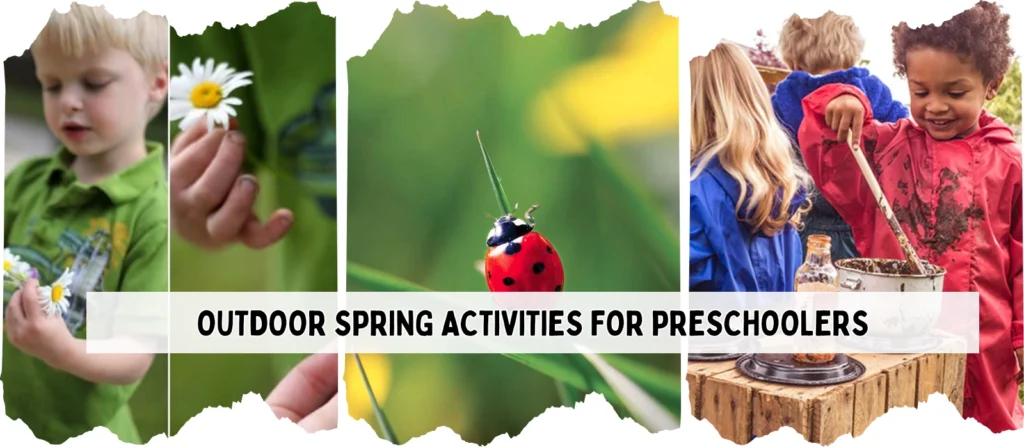
Outdoor Spring Activities for Preschoolers
1. Flower Counting Garden
Activity Introduction: This outdoor activity for preschoolers blends early math skills with nature exploration. Spring is the perfect time to count petals, compare colors, and identify flower types, giving children a foundation in numbers, patterns, and scientific observation.
Materials Needed:
- Clipboards or charts
- Crayons or markers
- Access to garden or flower beds
How to Do It: Visit a garden or green space. Ask preschoolers to count petals, compare shapes, or tally how many flowers they see by color. Draw or record findings to support visual learning.
2. Bug Safari
Activity Introduction: This thrilling outdoor activity for preschoolers develops curiosity and observational focus. Hunting for bugs promotes empathy for living creatures, strengthens fine motor skills, and introduces insect-related vocabulary.
Materials Needed:
- Bug viewers or magnifying glasses
- Collection jars (with ventilation)
- Insect ID charts
How to Do It: Guide children in a gentle bug hunt. Turn over rocks, inspect plants, and look in shaded areas. Observe safely and return bugs to nature afterward. Discuss habitats and body parts.
3. Rainbow Color Hunt
Activity Introduction: Springtime is full of colors, and this outdoor activity for preschoolers transforms a walk into a color-sorting adventure. It boosts visual discrimination, vocabulary, and categorization skills.
Materials Needed:
- Color chart or rainbow card
- Paper bags or baskets
How to Do It: Ask kids to find natural items that match each color of the rainbow. Group and discuss what they found. Use the collections for sorting games or art activities later.
4. Mud Kitchen Play
Activity Introduction: Messy but magical, this sensory-rich outdoor activity for preschoolers encourages creativity, social interaction, and fine motor development. It’s a wonderful spring activity when the ground is soft and full of material.
Materials Needed:
- Bowls, spoons, pots, pans
- Dirt, water, and natural materials (leaves, twigs)
How to Do It: Set up a mud kitchen space with tools. Let kids mix, scoop, pour, and pretend to cook using mud and garden materials. Encourage dialogue and cooperative play.
5. Bird Watching Bingo
Activity Introduction: This outdoor spring activity for preschoolers fosters patience, focus, and environmental awareness. Bird watching teaches sound recognition and builds descriptive language as kids observe and describe different birds.
Materials Needed:
- Binoculars (optional)
- Bird ID cards or Bingo sheets
How to Do It: Sit in a quiet outdoor space. Let kids look and listen for birds. Mark sightings on a Bingo board and discuss bird names, colors, and behaviors.
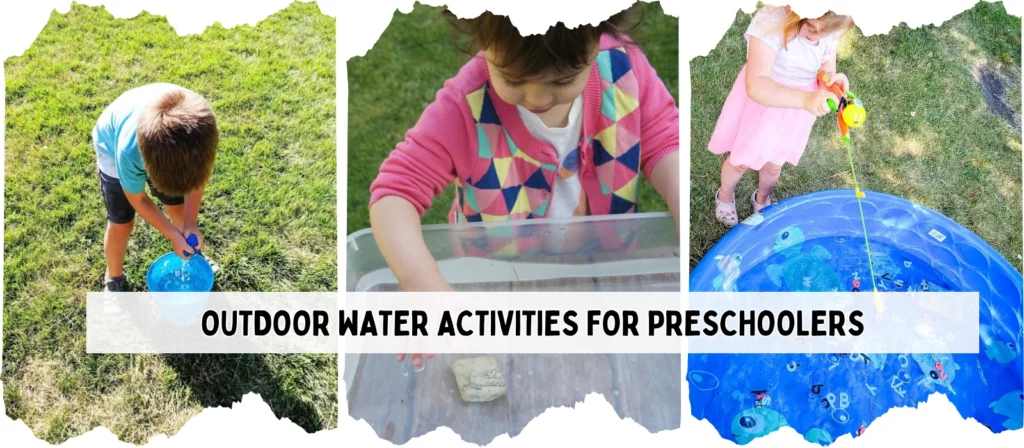
Outdoor Water Activities for Preschoolers
1. Water Relay Race
Activity Introduction: This outdoor water activity for preschoolers brings together teamwork, movement, and sensory excitement. It’s a high-energy way to develop balance, coordination, and timing, especially effective during hot summer days when kids need to stay cool and active.
Materials Needed:
- Buckets
- Sponges or cups
- Start/finish lines
How to Do It: Divide children into teams. Each player fills a sponge or cup with water, runs to the finish line to dump it in a bucket, then returns. The first team to fill their bucket wins. Repeat for fun and keep it light-hearted.
2. Water Wall Construction
Activity Introduction: A creative and problem-solving focused outdoor activity for preschoolers, this setup introduces basic engineering and encourages fine motor practice. Children build pathways for water, exploring gravity, flow, and prediction through play.
Materials Needed:
- Funnels, tubes, bottles, scoops
- Pegboards or fences
- Buckets of water
How to Do It: Help children construct a water wall on a fence using recycled materials. Pour water from the top and let them observe its path. Modify designs to alter speed or direction. Discuss observations and improvements.
3. Sink or Float Science
Activity Introduction: This outdoor activity for preschoolers combines water play with early science skills. Kids experiment with different materials and learn about density, prediction, and categorization through hands-on investigation.
Materials Needed:
- Large water tub
- Variety of small objects (plastic toys, leaves, stones)
- Charts for results
How to Do It: Let preschoolers drop each item in water and predict whether it will sink or float. Sort results, discuss why, and relate them to real-life examples like boats or balloons.
4. Fishing for Letters
Activity Introduction: A perfect blend of water fun and early literacy, this outdoor water activity for preschoolers improves fine motor control, letter recognition, and phonics awareness.
Materials Needed:
- Plastic or foam letters
- Small nets or scoops
- Kiddie pool or large basin
How to Do It: Scatter letters in water. Ask children to scoop out letters you call out, spell their name, or match sounds to symbols. Add number fishing for math practice.
5. Car Wash Station
Activity Introduction: This playful outdoor water activity for preschoolers develops responsibility, coordination, and sensory exploration. Kids love washing their toys, bikes, or even small furniture, which offers practical life skills through pretend play.
Materials Needed:
- Sponges, brushes
- Soapy water, rinse bucket
- Toy cars, tricycles, or plastic chairs
How to Do It: Set up a wash area. Show how to lather, scrub, and rinse. Kids take turns or work together. Add time challenges or music to increase engagement.
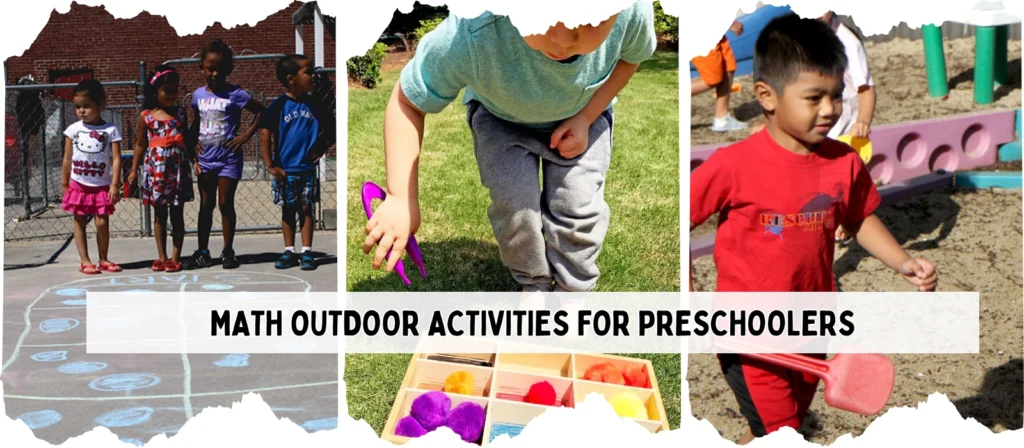
Math Outdoor Activities for Preschoolers
1. Nature Number Line
Activity Introduction: This outdoor activity for preschoolers introduces basic number concepts in a physical and visual way. Creating a number line using natural items helps children understand sequencing, quantity, and early addition or subtraction in an interactive setting.
Materials Needed:
- Rocks, leaves, sticks
- Number cards or chalk
How to Do It: Arrange natural objects in a line, labeling them with numbers. Walk along the line counting aloud, or ask children to hop to certain numbers. Practice simple math by adding or removing items.
2. Hop and Count Squares
Activity Introduction: A fun gross motor math outdoor activity for preschoolers that reinforces number recognition and counting. It combines movement with learning, making it ideal for kinesthetic learners.
Materials Needed:
- Chalk
- Outdoor space
How to Do It: Draw numbered squares on the ground. Call out numbers for children to hop to, or ask them to count aloud as they move. You can increase the challenge with number sequences or skip counting.
3. Counting Nature Hunt
Activity Introduction: This outdoor math activity for preschoolers strengthens counting and grouping skills. Children collect items from nature and sort them, promoting both number sense and environmental appreciation.
Materials Needed:
- Baskets or bags
- Chart or board
How to Do It: Assign a number (e.g., find 5 leaves, 3 sticks). Children collect and group their items accordingly. Review results and compare quantities to introduce more math vocabulary like “more,” “less,” and “equal.”
4. Shape Sorting Trail
Activity Introduction: A geometry-focused outdoor activity for preschoolers that helps identify, classify, and compare shapes found in the natural world. It enhances visual perception and cognitive skills.
Materials Needed:
- Printed shape cards
- Outdoor area with diverse objects
How to Do It: Give children shape cards and ask them to find and collect or point out items that match. Encourage discussion about curved vs. straight edges, sizes, and symmetry.
5. Math Toss Game
Activity Introduction: A versatile outdoor activity for preschoolers that blends throwing games with number practice. It improves gross motor skills while reinforcing numerals, addition, or subtraction.
Materials Needed:
- Beanbags
- Buckets labeled with numbers
How to Do It: Children toss beanbags into buckets and add or subtract the values they land in. Adjust the difficulty based on age and introduce team challenges for group engagement.
Safety Tips for Preschool Outdoor Activities
Outdoor activities for preschoolers should always prioritize safety. Outdoor activities for preschoolers are only effective when conducted in a secure and structured environment. While these outdoor activities for preschoolers promote learning and fun, they must be carefully supervised. Inspect all play areas for hazards, such as sharp objects, uneven ground, or toxic plants before allowing any outdoor activities for preschoolers to begin.
Make sure children are dressed appropriately for the weather, and that sunscreen or insect repellent is applied when needed for outdoor activities for preschoolers. Keep first-aid kits nearby and maintain adult-to-child ratios suitable for the age group. When using tools or props in outdoor activities for preschoolers, always demonstrate safe use first. Encouraging children to clean up after themselves after outdoor activities for preschoolers also fosters responsibility.
Finally, never underestimate the importance of hydration, especially in summer outdoor activities for preschoolers. Water breaks and shaded rest areas should be part of any plan involving outdoor activities for preschoolers.
How to Choose Outdoor Furniture and Toys for Preschoolers
When planning outdoor activities for preschoolers, selecting the right furniture and play equipment is key. Outdoor activities for preschoolers thrive in environments where tools and toys are age-appropriate and safe. Quality outdoor furniture should be child-sized, made from durable and weather-resistant materials, and designed with preschool safety in mind.
Look for products that support outdoor activities for preschoolers by encouraging movement, creativity, and collaboration. At XIHA Furniture, we offer outdoor preschool furniture that supports diverse outdoor activities for preschoolers—from sand and water tables to safe climbing structures. Our solutions are built for both safety and fun.

Frequently Asked Questions
Q: How often should outdoor activities for preschoolers be scheduled?
A: Ideally, preschoolers should have at least 60–90 minutes of outdoor activities for preschoolers every day, weather permitting.
Q: What’s the best way to adapt outdoor activities for preschoolers of different abilities?
A: Offer multi-level outdoor activities for preschoolers, allow choice in participation, and provide supportive tools.
Q: Are there specific outdoor activities for preschoolers that enhance academic learning?
A: Yes! Activities like alphabet hunts, math toss games, and nature-based experiments are excellent academic outdoor activities for preschoolers.
Q: How can I ensure safety during water-based outdoor activities for preschoolers?
A: Always supervise closely, use shallow containers, and avoid slippery surfaces during outdoor activities for preschoolers that involve water.
Conclusion
Outdoor activities for preschoolers are essential for holistic development. From literacy to math, physical growth to creativity, these hands-on outdoor activities for preschoolers shape confident, curious learners. At XIHA Furniture, we’re proud to support schools with reliable equipment tailored for outdoor activities for preschoolers. Let’s build better outdoor classrooms—together.

